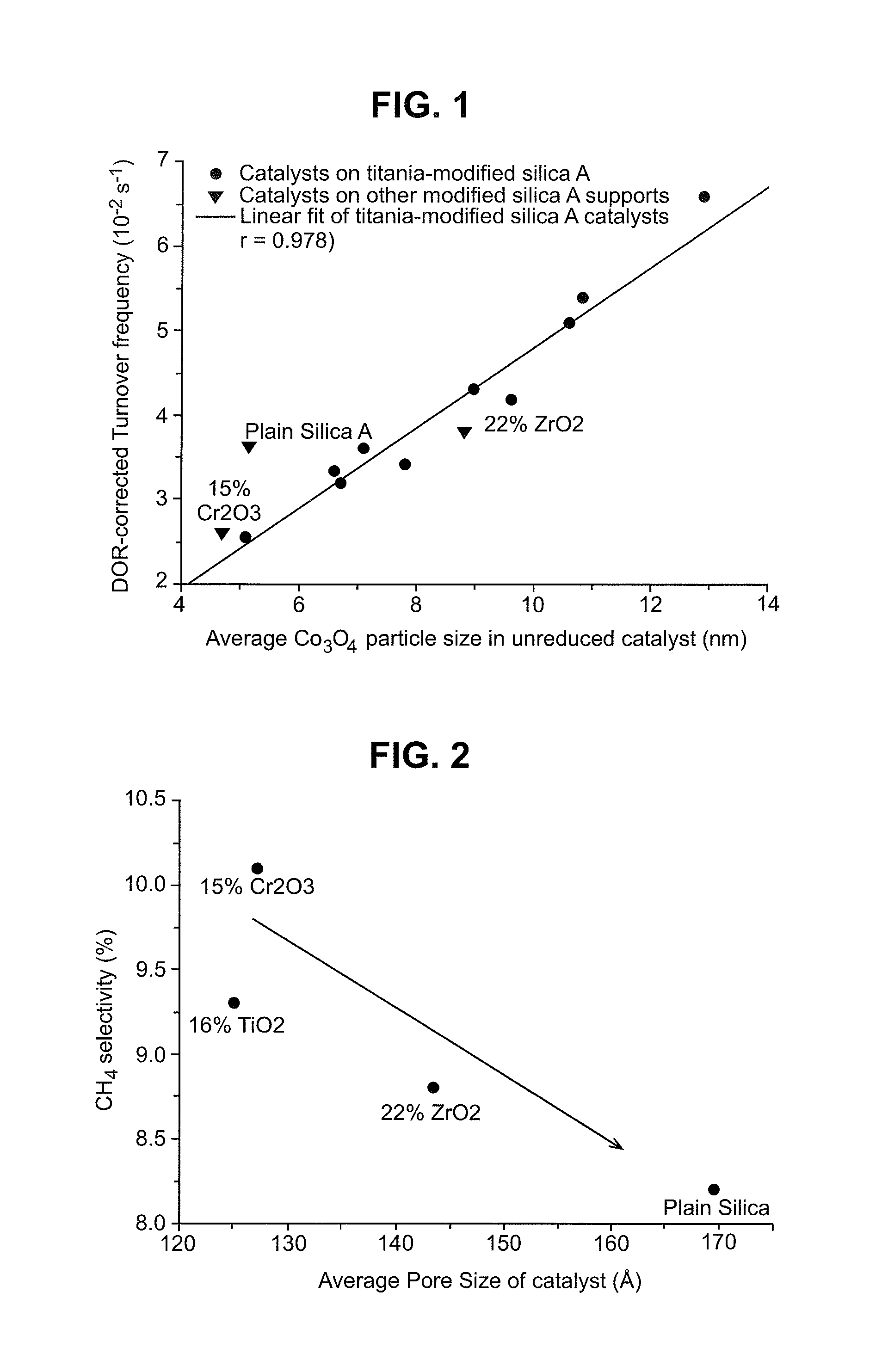Treating of catalyst support
a catalyst and support technology, applied in the field of catalyst support treatment, can solve the problems of lowering manufacturing costs, and achieve the effect of reducing catalyst stability
- Summary
- Abstract
- Description
- Claims
- Application Information
AI Technical Summary
Benefits of technology
Problems solved by technology
Method used
Image
Examples
example 1
Synthesis of ZrO2-Modified Silica Catalyst Support (22% ZrO2 / SiO2) Using Method a (Supports A1 to A3)
[0192]Silica A bare catalyst support material was dried at 100° C. for 2 hours. 31.4 g of silica was weighed and allowed to cool to room temperature. 8.82 g citric acid was mixed with 12 ml H2O and heated to about 50° C. with stirring until fully dissolved. The solution was then allowed to cool to room temperature. 16.22 g zirconium dinitrate oxide hydrate (also known as “zirconyl nitrate”) was mixed with 15 ml H2O and stirred using a magnetic stirbar, without heat, for 20 minutes to obtain a translucent solution. The zirconyl nitrate solution and citric acid solution were mixed together to form the impregnation solution. The impregnation solution was used immediately after preparation to impregnate the silica support. The support was impregnated by mixing the impregnation solution and the silica in order to reach the point of incipient wetness.
[0193]Following impregnation, a portion...
example 2 (
Reference)
Synthesis of ZrO2-Modified Silica Catalyst Support (22% ZrO2 / SiO2) Using Method B (Support B)
[0198]Silica A bare catalyst support material was dried at 100° C. for 2 hours. 31.4 g of silica was weighed and allowed to cool to room temperature. The impregnation solution was prepared by mixing 16.22 g zirconyl nitrate with 30 ml H2O and stirring using a magnetic stirbar, without heat, for 20 minutes to obtain a translucent solution with a total volume of 33 ml. The impregnation solution was used immediately after preparation to impregnate the silica support. The support was impregnated by mixing the impregnation solution and the silica in order to reach the point of incipient wetness.
[0199]Following impregnation, the modified catalyst support was dried in a muffle furnace at a temperature that increased at a ramp rate of 2° C. / min up to 100° C. The temperature was held at 100° C. for 10 hours (support B, code 1112-13-005-4).
[0200]The resulting catalyst support B had ZrO2 boun...
example 3
Synthesis of Mn2O3-modified Silica Catalyst Support (15% Mn2O3 / SiO2) Using Method a (Support C)
[0201]Silica A bare catalyst support material was dried at 100° C. for 2 hours. 16.8 g of silica was weighed and allowed to cool to room temperature. 4.71 g citric acid was mixed with 8 ml H2O and heated to about 50° C. with stirring until fully dissolved. The solution was cooled to about 35° C., then 9.57 g of manganese nitrate was added and the solution was stirred until fully dissolved. The volume of the solution was adjusted to 19 ml with H2O to form the impregnation solution and then allowed to cool to room temperature. The impregnation solution was used to impregnate the silica support by mixing the impregnation solution and the silica in order to reach the point of incipient wetness.
[0202]Following impregnation, the modified catalyst support was dried in a muffle furnace at a temperature that increased at a ramp rate of 2° C. / min up to 100° C. The temperature was held at 100° C. for...
PUM
| Property | Measurement | Unit |
|---|---|---|
| temperature | aaaaa | aaaaa |
| temperature | aaaaa | aaaaa |
| particle diameter | aaaaa | aaaaa |
Abstract
Description
Claims
Application Information
 Login to View More
Login to View More - R&D
- Intellectual Property
- Life Sciences
- Materials
- Tech Scout
- Unparalleled Data Quality
- Higher Quality Content
- 60% Fewer Hallucinations
Browse by: Latest US Patents, China's latest patents, Technical Efficacy Thesaurus, Application Domain, Technology Topic, Popular Technical Reports.
© 2025 PatSnap. All rights reserved.Legal|Privacy policy|Modern Slavery Act Transparency Statement|Sitemap|About US| Contact US: help@patsnap.com



